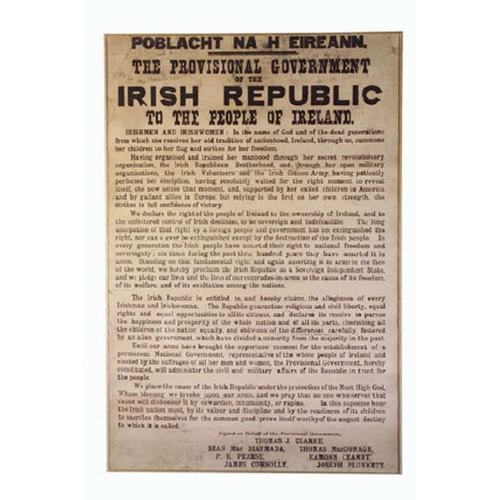.jpg)
Saturday 20th November 2021 - Della Bentham
.jpg)
An original copy Easter 1916 Proclamation document is up for auction in the Matthews Auctioneers Two-Day Auction running on November 27th -28th.
The document, which is 30 x 19.5 inches, is a rare survivor and is considered the most crucial document in the history of the Irish Nation.

Issued by the Irish Volunteers and the Irish Citizen Army, it was read by Padraig Pearse from the steps of the GPO on O Connell Street on Easter Monday Morning, April 24th, 1916. It is believed that Pearse originally wrote the document, with additional amendments, before committing to print by James Connelly and Thomas McDonagh.
Modelled on a similar document issued by Robert Emmet in the smaller 1803 rebellion, the document proclaims Ireland's independence from the United Kingdom. It called for a new Irish government, representative of "the whole people of Ireland and elected by the suffrages of all her men and women". This was significant because, at the time, women of most European countries did not yet have the right to vote. The seven leaders declared themselves the 'Provisional Government of the Irish Republic'.
Initially, the Leaders planned to print about 2,000 copies in the basement of Liberty Hall, the Irish Citizen Army's headquarters, and distribute them nationwide on Easter Monday morning. However, difficulties in the secrecy of its printing, amongst other issues, meant that only 500 or so were eventually produced.
The layout and design of the document were affected by a scarcity of paper and the metal-type employed. With not enough type to print in one run and the rollers refusing to apply even pressure throughout, the document was printed in two halves onto the same piece of paper - printing first the top, then the lower half.
Because they further lacked a sufficient supply of type in the same size and font, some parts of the document use 'e's' from a different font, which are smaller and don't quite match. The lack of even pressure in the application to the sheet is also evident with smudging in some parts and faint printing in others.
The printed copies were run-off a dilapidated Summit Wharfdale Stop Cylinder Press operated by three men: Christopher Brady, the printer, and two compositors, Michael Molly and Liam O'Brien. These men were essentially kept under house arrest by Pearse during the setting and printing process so that it would appear to the British, if raided, that the printers were working under duress. The printing itself was supervised by James Connelly.
Of the 500 copies eventually produced, most were destroyed when the British Army stormed Liberty Hall. The few that remained with the Leaders were pasted up on public walls in and around Dublin on Easter Monday morning. These served as a public notice to all of Ireland's declaration of independence from the United Kingdom. Of these, most were roughly destroyed very soon after being posted up. It is now believed that only about 20 or so intact copies survived. Of these, about three remain in private hands.
This copy has some damages and repairs, including an amended tear, which is to be expected. It is a National Icon and a poignant reminder of those turbulent days of revolution. The opening lines of the document read: "Irishmen and Irishwomen: in the name of God and of the dead generations from which she receives her old traditions of nationhood, Ireland, through us, summons her children to her flag and strikes for her freedom".
In 1916, Britain was in the midst of the First World War, which saw almost a million British soldiers killed in bloody conflict with Germany. The 1916 Proclamation was considered treason by the British Government because it controversially referenced 'gallant allies in Europe', referring to the German Empire that had previously supplied the Irish rebels with arms.
The 1916 rebellion was crushed, but widespread support for independence persisted. The IRA (Irish Republican Army) launched an effective guerrilla campaign against British forces in 1919. A cease-fire was declared in 1921, and, early the following year, a faction of Irish nationalists signed a peace treaty with Britain. This treaty called for the partition of Ireland, with the six northern counties remaining in the UK and the south becoming independent.
The Irish people adopted a constitution in 1927 which declared Ireland a sovereign, independent and democratic state. In 1949 the last remaining link with the commonwealth was severed by the Republic of Ireland Act.
In 2016, an original copy of the 1916 Proclamation was sold at auction in Dublin for £117,000. More recently, in 2018, one was withdrawn from auction and sold to a private buyer for €100,000.
You can view the auction listing or register to bid live here.